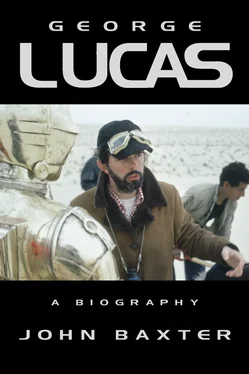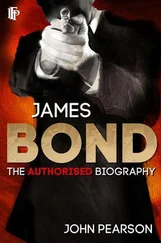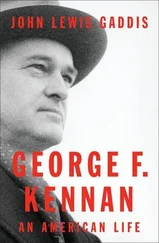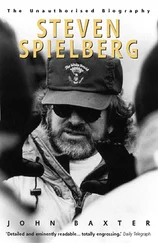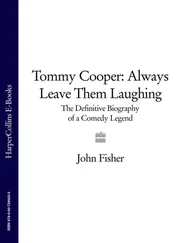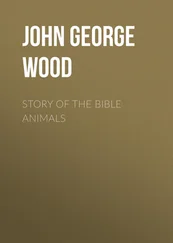How he met George Lucas has long been a subject of rival mythologies. Dale Pollock, in the semi-authorized Skywalking , says simply, ‘Wexler took a liking to the weird skinny kid whose head was bursting with ideas. He went so far as to telephone some friends of his on USC’s film school faculty and advised them to watch out for Lucas. “For God’s sake, keep an eye on the kid,” Wexler told one faculty member [presumably Gene Peterson, who had been his assistant and who now taught cinematography there]. “He’s got the calling.” But Wexler did not get Lucas into USC, as legend has it. Lucas had applied to the film school prior to meeting Wexler, and to George’s and his father’s amazement, he was accepted.’
Other sources make a more direct link, and emphasize Wexler’s role. Charley Lippincott, who was at USC with Lucas and who would become his head of publicity and marketing, discounts the later story, encouraged by Lucas, that he had already made up his mind to enter film when he met Wexler: ‘Wexler was up there doing a film about cars [probably The Bus , a documentary Wexler wrote, shot, and directed], and George helped him out, working on the film as production assistant or something.’
As an aficionado of car racing, Wexler inevitably ran into Allen Grant. As they talked, Wexler complained that he was having trouble with his Citroën-Maserati, notorious for its tricky timing. Grant said he knew someone who could help, a guy who’d been his mechanic and co-driver, and who was interested in movies too. ‘George met up with Haskell Wexler,’ says Lippincott, ‘and told him he didn’t know what he wanted to do, but that he was interested in film. And Haskell got him into USC. He’s the one who persuaded him. I don’t think George really knew that much about film at the time.’
John Plummer also played a part. His grades were better than Lucas’s, and he wanted to enter USC in Los Angeles as a business major. He was going to LA to take the admission tests, and asked Lucas to keep him company. In fact, why didn’t he take the test too? ‘So I said, “All right,”’ Lucas recalled, “‘but it’s a long shot, ’cause my grades aren’t good enough to get into a school like that.” So I went and took the test and I passed. I got accepted!’
[I want to thank] my teachers from kindergarten through college, their struggle – and it was a struggle – to help me learn to grow …
George Lucas in his speech to the Academy of Motion Picture
Arts and Sciences, accepting the Irving Thalberg Award,
30 March 1992
Lucas enrolled at USC as a film major. His junior college courses counted toward credit, so he could skip his freshman and sophomore years, and enter as a junior.
Even then, his father still opposed the move, and scorned the whole idea of training for cinema. ‘You’re just going to become a ticket-taker at Disneyland,’ he told him. ‘You’re never going to get a real job.’ He also doubted his son’s will: ‘You’ll be back in a few years.’ George lost his temper. ‘I’m never coming back!’ he shouted. ‘I’m going to be a millionaire before I’m thirty.’
Persistence wore Lucas Sr down. In an ingenious compromise, he offered to send his son through USC as an employee of the Lucas Company. He’d pay him a salary equal to his tuition fees, plus $200 a month – a substantial amount at a time when one could rent a very basic apartment for half that. If George didn’t persevere with the course, he could be fired like any stock-room boy. With little choice in the matter, he took the deal.
In the early summer of 1964, he came down to Los Angeles. John Plummer was sharing an apartment in the beachside suburb of Malibu, and Lucas moved in. To fill in before courses and his $200-a-month payment started, he waited tables and did drawings of surfer girls with the wide and dewy eyes of orphan children, which he hawked on the beach.
He also looked for part-time work in the film business. Ventura Boulevard, which ran along the San Fernando Valley side of the mountains separating the city’s sprawling dormitory suburbs from Hollywood and Beverly Hills, was lined with two- and three-story office buildings, most of which harbored at least one film company. Lucas visited scores of them. He was the ten thousandth hopeful to do so, and, like everybody else, he found that the fanciful titles of those companies disguised mostly nickel-and-dime operations: freelance editors, producers of educational documentaries, or distributors of 16mm films. Real producers usually had office space on or near one of the big movie-company lots, walled cities where security guards barred anyone without a pass or an appointment.
Lucas checked into USC for his first semester in fall 1964. The university wasn’t anything like he expected. It had a notable reputation for high academic distinction. One writer called it ‘a citadel of privilege.’ For decades it had supplied Los Angeles with its public officials, doctors, and engineers. But unlike UCLA, set among the lawns and groves of pepper trees in the elegant suburb of Westwood, USC had to content itself with what buildings it could find in its area of east LA, an old residential district through which the campus had metastasized over the years.
The best of USC’s buildings shared the twenties faux- Spanish architecture of the Shrine Auditorium, the area’s most distinctive structure, for many years Hollywood’s village hall, and the site of the annual Academy Awards ceremony. The worst were functional at best, and were usually allocated to courses which stood well down the list from medicine, engineering, and law. On that scale, the film school, part of the theater department, ranked lowest of all.
Lucas, like all new arrivals, asked, ‘Where’s the theater department?’
‘Over there.’
‘But … that’s a little house .’
‘That’s it.’
‘Where are the theaters?’
‘Well, we actually only have one. It’s an auditorium, and it was built in 1902.’
Despite the grandiose Spanish-style gate that led to it, the film department consisted of three single-story wooden buildings in an expanse of open ground. They’d been stables for the horses of cavalrymen stationed there during World War I. In the twenties, it was the school of architecture, then, after 1929, the film school. Following World War II, the college erected two more army-surplus wooden barracks buildings to house an audio-visual unit which mainly trained government and military personnel to use educational film materials. On the side, it produced instructional films. That unit became the nucleus of the USC Cinema School.
The school had a bare minimum of facilities. The old stables became a sound stage, with a screening room next door, always called Room 108, with 35mm and 16mm projection. Editing machines – ancient upright Moviolas – were crammed into single large room, next to a storage space for cameras and other movie equipment. Classrooms, each with its own 16mm projector, occupied the barracks. There was nowhere to hang out, so students congregated in an open space in the middle of the buildings.
Students were required to live on campus for the first year. A high-rise dormitory, one of the college’s few modern buildings, loomed over the cinema department, but it was reserved for female students. Most males, including Lucas, occupied Touton Hall, an older building across campus. It had no cafeteria, so he either had to trudge to the women’s dorm and suffer its famously inedible food, or eat in the neighborhood – not then as dangerous as it became after the 1965 riots in nearby Watts.
To his alarm, he found he wouldn’t have a room of his own. The college did make an effort to match up people of like interests, so he found himself sharing with Randy Epstein. A genial Angeleno, Epstein, now a successful Californian property developer, was used to prosperity, and was surprised by Lucas’s Spartan possessions – which consisted mostly of a Nikon 35mm camera and some clothes. He didn’t even have a stereo, a deficiency which Epstein remedied.
Читать дальше
